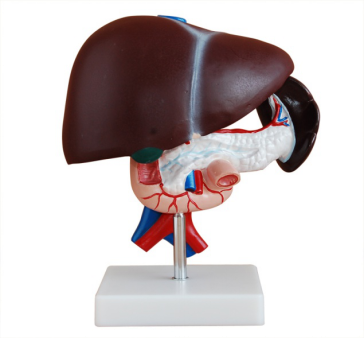Homepageпјҡ NEWS >> The role of hepatopancreatic duodenal model in clinical practice
Hepatopancreatic duodenal model plays a vital role in clinical practice, which not only provides intuitive learning tools for doctors, but also provides strong support for clinical diagnosis and treatment in many aspects.

First, the primary role of the hepatopancreatic duodenal model in clinical practice is to help physicians with preoperative planning and simulation. This model accurately shows the anatomy of the liver, pancreas, and duodenum, as well as their relative positions and relationships. Through careful observation and operation of the model, doctors can simulate the surgical process, predict possible difficulties and challenges, and formulate detailed surgical plans accordingly. This preoperative planning and simulation process can greatly reduce the risk of surgery and improve the success rate of surgery.
Secondly, hepatopancreatic duodenal model plays an important role in case discussion. In clinical practice, doctors often need to discuss complex cases to develop the best treatment plan. The hepatopancreatic duodenal model can be used as an intuitive tool to give doctors a clearer understanding of the anatomical structure and pathological changes of the case. Through the operation and discussion of the model, doctors can more deeply understand the characteristics of the cases, find possible diagnostic errors, and formulate a more scientific and reasonable treatment plan
In addition, hepatopancreatic duodenal model has been widely used in clinical research. With the continuous development of medical technology, new surgical methods and treatment methods continue to emerge. The hepatopancreatic duodenal model can be used as an important research tool to evaluate the feasibility and effectiveness of new surgical approaches. By simulating the model, researchers can understand the specific steps and precautions of new surgical methods, find possible problems and improvements, and provide a more reliable basis for clinical practice.
Finally, hepatopancreatic duodenal model also plays an important role in clinical teaching. Medical education needs to cultivate students' practical ability and clinical thinking. The hepatopancreatic duodenal model can be used as an intuitive teaching tool to help students better understand the anatomical structure and function of the digestive system and master relevant clinical knowledge and skills. Through the operation and discussion of the model, students can have a deeper understanding of the problems and challenges in clinical practice and improve their clinical abilities.
In summary, hepatopancreatic duodenal model plays an important role in clinical practice. It can not only help doctors with preoperative planning and simulation, case discussion and research work, but also serve as an important tool in medical education and improve students' clinical abilities. Therefore, in the field of clinical medicine, the application of hepatopancreatic duodenal model will be more and more extensive.